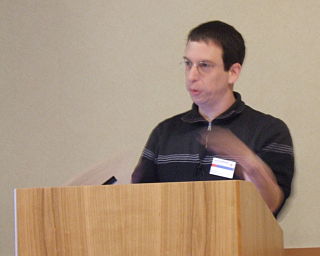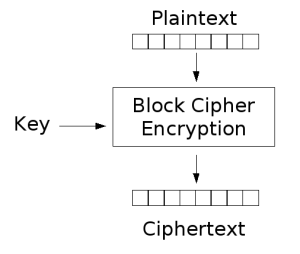A chosen-ciphertext attack (CCA) is an attack model for cryptanalysis where the cryptanalyst can gather information by obtaining the decryptions of chosen ciphertexts. From these pieces of information the adversary can attempt to recover the secret key used for decryption.
Identity-based encryption (IBE), is an important primitive of identity-based cryptography. As such it is a type of public-key encryption in which the public key of a user is some unique information about the identity of the user. This means that a sender who has access to the public parameters of the system can encrypt a message using e.g. the text-value of the receiver's name or email address as a key. The receiver obtains its decryption key from a central authority, which needs to be trusted as it generates secret keys for every user.
The Paillier cryptosystem, invented by and named after Pascal Paillier in 1999, is a probabilistic asymmetric algorithm for public key cryptography. The problem of computing n-th residue classes is believed to be computationally difficult. The decisional composite residuosity assumption is the intractability hypothesis upon which this cryptosystem is based.
A deterministic encryption scheme is a cryptosystem which always produces the same ciphertext for a given plaintext and key, even over separate executions of the encryption algorithm. Examples of deterministic encryption algorithms include RSA cryptosystem, and many block ciphers when used in ECB mode or with a constant initialization vector.
Plaintext-awareness is a notion of security for public-key encryption. A cryptosystem is plaintext-aware if it is difficult for any efficient algorithm to come up with a valid ciphertext without being aware of the corresponding plaintext.
Homomorphic encryption is a form of encryption that allows computations to be performed on encrypted data without first having to decrypt it. The resulting computations are left in an encrypted form which, when decrypted, result in an output that is identical to that produced had the operations been performed on the unencrypted data. Homomorphic encryption can be used for privacy-preserving outsourced storage and computation. This allows data to be encrypted and outsourced to commercial cloud environments for processing, all while encrypted.

Dan Boneh is an Israeli–American professor in applied cryptography and computer security at Stanford University.
Yuriy Sergeyevich Polyakov is a Russian-American scientist at Duality Technologies. He is best known for his work in cryptography, chemical engineering, and physics.
Lattice-based cryptography is the generic term for constructions of cryptographic primitives that involve lattices, either in the construction itself or in the security proof. Lattice-based constructions support important standards of post-quantum cryptography. Unlike more widely used and known public-key schemes such as the RSA, Diffie-Hellman or elliptic-curve cryptosystems — which could, theoretically, be defeated using Shor's algorithm on a quantum computer — some lattice-based constructions appear to be resistant to attack by both classical and quantum computers. Furthermore, many lattice-based constructions are considered to be secure under the assumption that certain well-studied computational lattice problems cannot be solved efficiently.
In discrete mathematics, ideal lattices are a special class of lattices and a generalization of cyclic lattices. Ideal lattices naturally occur in many parts of number theory, but also in other areas. In particular, they have a significant place in cryptography. Micciancio defined a generalization of cyclic lattices as ideal lattices. They can be used in cryptosystems to decrease by a square root the number of parameters necessary to describe a lattice, making them more efficient. Ideal lattices are a new concept, but similar lattice classes have been used for a long time. For example, cyclic lattices, a special case of ideal lattices, are used in NTRUEncrypt and NTRUSign.

Functional encryption (FE) is a generalization of public-key encryption in which possessing a secret key allows one to learn a function of what the ciphertext is encrypting.
Shai Halevi is a computer scientist who works on cryptography research at Amazon Web Services.
In post-quantum cryptography, ring learning with errors (RLWE) is a computational problem which serves as the foundation of new cryptographic algorithms, such as NewHope, designed to protect against cryptanalysis by quantum computers and also to provide the basis for homomorphic encryption. Public-key cryptography relies on construction of mathematical problems that are believed to be hard to solve if no further information is available, but are easy to solve if some information used in the problem construction is known. Some problems of this sort that are currently used in cryptography are at risk of attack if sufficiently large quantum computers can ever be built, so resistant problems are sought.
Craig Gentry is an American computer scientist working as CTO of TripleBlind. He is best known for his work in cryptography, specifically fully homomorphic encryption.

Jung Hee Cheon is a South Korean cryptographer and mathematician whose research interest includes computational number theory, cryptography, and information security. He is one of the inventors of braid cryptography, one of group-based cryptography, and approximate homomorphic encryption HEAAN. As one of co-inventors of approximate homomorphic encryption HEaaN, he is actively working on homomorphic encryptions and their applications including machine learning, homomorphic control systems, and DNA computation on encrypted data. He is particularly known for his work on an efficient algorithm on strong DH problem. He received the best paper award in Asiacrypt 2008 for improving Pollard rho algorithm, and the best paper award in Eurocrypt 2015 for attacking Multilinear Maps. He was also selected as Scientist of the month by Korean government in 2018 and won the POSCO TJ Park Prize in 2019.
HEAAN is an open source homomorphic encryption (HE) library which implements an approximate HE scheme proposed by Cheon, Kim, Kim and Song (CKKS). The first version of HEAAN was published on GitHub on 15 May 2016, and later a new version of HEAAN with a bootstrapping algorithm was released. Currently, the latest regular version is version 1.1 and the latest pre-release version is 2.1.

Simple Encrypted Arithmetic Library or SEAL is a free and open-source cross platform software library developed by Microsoft Research that implements various forms of homomorphic encryption.
Homomorphic Encryption library or HElib is a free and open-source cross platform software developed by IBM that implements various forms of homomorphic encryption.
OpenFHE is an open-source cross platform software library that provides implementations of fully homomorphic encryption schemes. OpenFHE is a successor of PALISADE and incorporates selected design features of HElib, HEAAN, and FHEW libraries.
Zvika Brakerski is an Israeli mathematician, known for his work on homomorphic encryption, particularly in developing the foundations of the second generation FHE schema, for which he was awarded the 2022 Gödel Prize. Brakerski is an associate professor in the Department of Computer Science and Applied Mathematics at the Weizmann Institute of Science.




